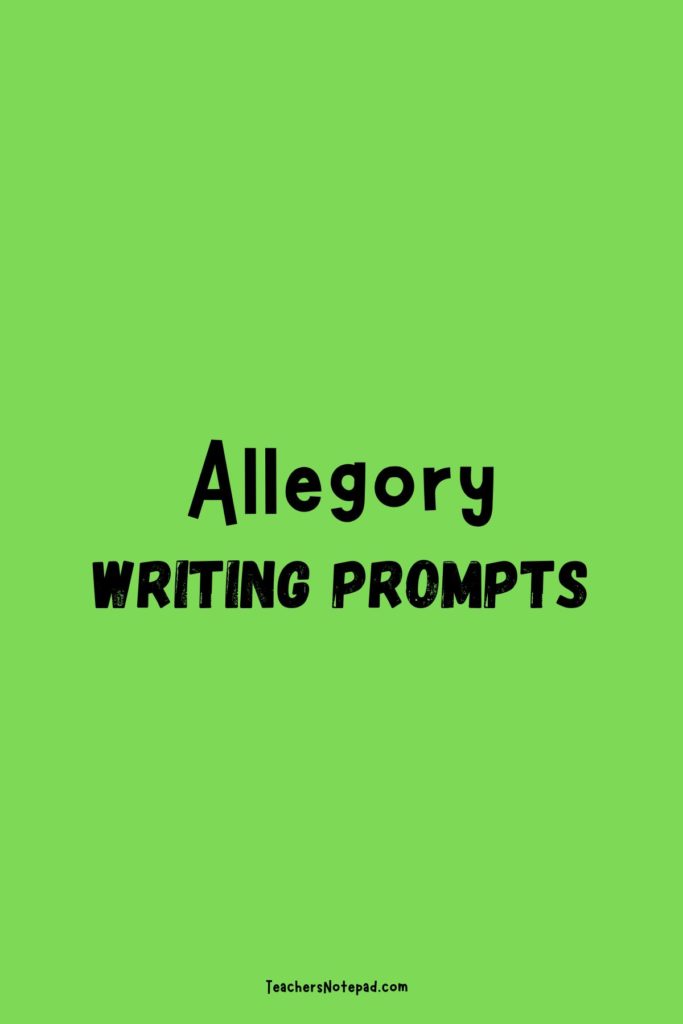An allegory is a piece of art, such as literature or a picture, that can be interpreted to reveal a deeper, hidden meaning.
Typically, this type of writing has political undertones, but there are other forms of allegory that your students will learn as they strengthen their writing skills.
Below, we’ve provided a list of prompts to help your young writers understand allegory and practice using this tool in their own writing.
Using This Guide
This writing guide can be used as homework or in tandem with your ELA curriculum.
The point is to get students to work on their nonfiction writing skills in a way that is fun and engaging.
A lot of these prompts encourage students to read stories they might not have read before, while others use old classics as examples.
Here are a few ways you can use the list below:
- Use these prompts for students who finish work early and need something to do.
- Pick prompts that line up with what students are learning in other classes (like history or art).
- Have each student pick a prompt for someone else in the class to use.
The Writing Prompts
- What is an allegory? Can you think of any examples of allegory in pop culture?
- Compare and contrast the differences between an allegory and a parable.
- How is the Disney animated movie Zootopia an example of allegory?
- How is The Wizard of OZ an example of allegory?
- Write an allegory that warns people of the dangers of extinction.
- Define four types of allegory.
- Compare and contrast the differences between an allegory and a fable.
- Write an allegory that tells of the dangers of peer pressure.
- What kind of allegory is used in “The Boy Who Cried ‘Wolf'”?
- Use allegory to explain why mental health is just as important as physical health.
- Write a story using classic allegory.
- What kind of allegory is used in The Chronicles of Narnia series? Explain.
- Tell a story about treating boys and girls as equals.
- Explain how The Giving Tree by Shel Silverstein uses allegory.
- Write an allegory that discusses the downfalls of materialism.
- Write a story using religious allegory.
- The Giver by Lois Lowry uses allegory to discuss individualism. Write a short story that sends a similar message.
- How does The Lorax by Dr. Seuss use allegory?
- Write an allegory that discusses the value of friendship.
- Write a story using modern allegory.
- Can allegory in children’s literature be used to teach lessons to adults? Explain with examples.
- Write an allegory that teaches the importance of being kind to animals.
- Write a story that explains that it’s okay for boys to show their emotions.
- What kind of allegory does A Bear Called Paddington by Michael Bond use? Explain.
- Write a story using political allegory.
- Write an allegory that teaches that slow and steady wins the race.
- Write a story about the battle between good and evil.
- Tell a story about the importance of being kind to others.
- Write an allegory that touches on the impact of racism in your community.
- Write a story about the importance of telling the truth.
- Tell a story about never being afraid to be yourself.
- Write an allegory that teaches about facing your fears.
- How does The Little Prince by Antoine de Saint-Exupéry use allegory? Explain.
- Tell a story about the importance of thinking before you speak.
- Write a story about finding the similarities in people who seem different from each other.
- How does The Paper Princess by Elisa Klevin use allegory? Explain.
- Tell a story about what happens when someone spreads a rumor.
- Write a story about the importance of loving yourself.
- How does Elmer by David McKee use allegory? Explain.
- Tell a story that shows that there are two sides to every story.
- Write a story that uses the idea, “don’t count your chickens before they hatch”.
- How does Blueberries for Sal by Robert McCloskey use allegory? Explain.
- Tell a story that shows the importance of perseverance.
- How does Alexander and the Terrible, Horrible, No Good, Very Bad Day by Judith Viorst use allegory? Explain.
Looking For More?
Our site is home to an abundance of educational resources that can be used at home or in the classroom.
If you are looking for something specific and we don’t have it, reach out and let us know! Our goal is to make learning fun and exciting for everyone involved.


